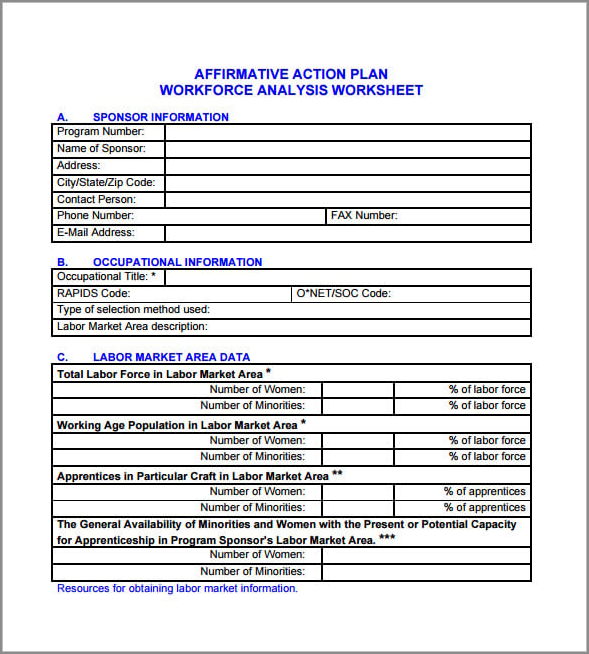
An affirmative action plan is a proactive approach taken by organizations to promote equal opportunity and diversity in the workplace. It is a set of policies and practices designed to eliminate discrimination and ensure that individuals from underrepresented groups have equal access to employment opportunities.
This article will explore the importance and benefits of implementing an affirmative action plan, as well as guide how to create an effective plan.
What is an Affirmative Action Plan?
An affirmative action plan is a documented program that outlines an organization’s commitment to creating a diverse and inclusive workforce. It includes specific goals, policies, and strategies aimed at recruiting, hiring, promoting, and retaining individuals from underrepresented groups. The plan is based on the principles of equal opportunity and non-discrimination and is designed to address historical and systemic barriers that have limited the representation of certain groups in the workforce.
Under an affirmative action plan, employers take proactive steps to identify and eliminate discriminatory practices and ensure that qualified individuals from underrepresented groups have equal access to employment opportunities. These steps may include targeted recruitment efforts, outreach programs, mentoring and training initiatives, and the establishment of diversity and inclusion committees or task forces.
Why is an Affirmative Action Plan Important?
An affirmative action plan is important for several reasons. Firstly, it helps organizations create a more diverse and inclusive workforce. Diversity brings different perspectives, experiences, and ideas to the table, which can lead to innovation, creativity, and better decision-making. Inclusivity, on the other hand, fosters a sense of belonging, increases employee engagement and productivity, and reduces turnover.
Secondly, an affirmative action plan helps address historical and systemic inequalities. Certain groups, such as women, racial and ethnic minorities, individuals with disabilities, and veterans, have historically faced barriers to equal employment opportunities. By actively recruiting and promoting individuals from these underrepresented groups, organizations can help level the playing field and create a more equitable society.
Lastly, implementing an affirmative action plan is not only the right thing to do, but it also makes good business sense. Studies have shown that diverse and inclusive organizations outperform their competitors. They are better able to attract and retain top talent, enhance their reputation as socially responsible employers, and tap into new markets and customer segments.
How to Create an Effective Affirmative Action Plan
Creating an effective affirmative action plan involves several key steps:
1. Conduct a Workforce Analysis
Start by conducting a thorough analysis of your current workforce demographics. Identify any underrepresented groups and areas where diversity is lacking. This analysis will help you set realistic goals and targets for increasing representation and measuring progress.
2. Define Goals and Objectives
Based on the workforce analysis, define specific goals and objectives for your affirmative action plan. These goals should be measurable, achievable, and aligned with your organization’s overall diversity and inclusion strategy.
3. Develop Recruitment and Outreach Strategies
Develop strategies to attract and recruit individuals from underrepresented groups. This may include partnering with community organizations, attending job fairs and career events targeted at these groups, and leveraging social media and online platforms to reach a wider audience.
4. Implement Training and Development Programs
Provide training and development opportunities to enhance the skills and competencies of your workforce. Offer mentoring programs, leadership development initiatives, and diversity and inclusion training to foster an inclusive and supportive work environment.
5. Establish Accountability and Monitoring Mechanisms
Establish accountability by assigning responsibility for implementing the affirmative action plan to specific individuals or teams. Regularly monitor and evaluate the progress of your plan, making adjustments as needed to ensure its effectiveness.
6. Communicate and Promote the Plan
Communicate your affirmative action plan to all employees and stakeholders. Highlight the benefits of diversity and inclusion, and encourage everyone to actively support and participate in the plan. Regularly share updates on progress and celebrate achievements.
7. Review and Update the Plan
Regularly review and update your affirmative action plan to ensure its continued relevance and effectiveness. As your organization evolves and external factors change, your plan should adapt accordingly.




The Benefits of an Affirmative Action Plan
An effective affirmative action plan can bring numerous benefits to an organization, including:
- Increased diversity: By actively recruiting individuals from underrepresented groups, organizations can create a more diverse workforce, bringing in a wider range of perspectives and ideas.
- Improved innovation and creativity: Diversity fosters innovation and creativity by encouraging different ways of thinking and problem-solving.
- Enhanced employee engagement and productivity: Inclusive workplaces where employees feel valued and respected tend to have higher levels of engagement and productivity.
- Reduced turnover: When employees feel included and supported, they are more likely to stay with the organization, reducing turnover and associated costs.
- Enhanced reputation: Organizations that prioritize diversity and inclusion are seen as socially responsible and attract top talent who value these principles.
- Access to new markets and customer segments: A diverse workforce can help organizations better understand and serve diverse customer segments and tap into new markets.
- Compliance with legal requirements: In many countries, including the United States, implementing an affirmative action plan is a legal requirement for federal contractors and subcontractors.
Conclusion
An affirmative action plan is a valuable tool for organizations committed to promoting diversity, inclusion, and equal opportunity. By implementing an effective plan, organizations can create a more diverse and inclusive workforce, foster innovation and creativity, enhance employee engagement and productivity, and reap the numerous benefits that come with a diverse workforce. It is not only the right thing to do, but it also makes good business sense in today’s global and interconnected world.
Affirmative Action Plan Template – Download